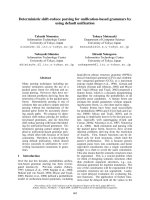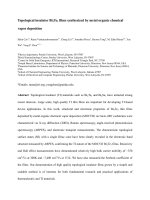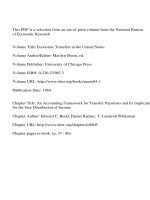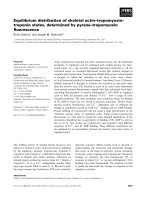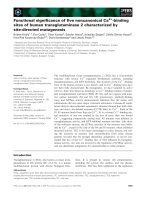Tape Reading By Linda Bradford Raschke_5 potx
Bạn đang xem bản rút gọn của tài liệu. Xem và tải ngay bản đầy đủ của tài liệu tại đây (210.11 KB, 19 trang )
August 20, 2007 Time: 05:40pm chapter05.tex
34
•
Chapter 5
Figure 5.1. Optimum nonannuitized assets.
course, γ = 1
T
0
F (z)e
−ρz
dz. The dynamic budget constraint is
˙
b(z) = γ a + ρb(z) − c(z),
(5.15)
with solution
b(z) = e
ρz
z
0
e
−ρx
(γ a − c(x)) dx+ W − a
. (5.16)
The amount of b(z) changes with age, depending on the consumption
path. The only constraint is that b(z) ≥ 0 for all z,0≤ z ≤ T. Hence,
W − a ≥ 0.
For simplicity, consider the special case σ = 1(u(c) = ln c), δ = 0, T =
∞, and F (z) = e
−αz
. For this case, γ = α + ρ. Maximization of expected
utility subject to (5.15) yields optimum consumption c
∗
(z) = c
∗
(0)e
(ρ−α)z
.
Assume that ρ − α>0, implying that consumption rises with age. Solve
for c
∗
(0) from (5.16), setting lim
z→∞
b(z)e
−ρz
= 0. Since b(0) ≥ 0, it
is optimum to set b(0) = 0 and a = W,orc
∗
(0) = α
(
(ρ + α)/ρ
)
W.
Substituting in (5.16) we obtain the optimum path, b
∗
(z). It is now seen
from (5.15) that
˙
b
∗
(0) =
(
(ρ − α)/ρ
)
(ρ + α)W > 0. Nonannuitized assets
accumulate and then decumulate to support the optimum consumption
trajectory (figure 5.1).
August 20, 2007 Time: 05:40pm chapter05.tex
Comparative Statics
•
35
5.5 Partial Annuitization: Low Returns on Annuities
Cannon and Tonks (2005) observe that the issuers of annuities (insurance
firms) invest their assets, for reasons of liquidity and risk, mainly in
bonds that yield a lower return than equities. While the reasons given
for this policy are rather weak (and as annuity markets grow, insurance
firms are expected to hold more balanced portfolios), this may be
another explanation why individuals annuitize only later in life, holding
nonannuitized assets at early ages.
To see this, let annuities have a rate of return of ρ
0
+ r(z), while
nonannuitized assets yield a return of ρ, ρ > ρ
0
. The budget constraint
(5.13) now becomes
˙
a(z) = (ρ
0
+ r)a(z) + ρb(z) + w(z) − c(z) −
˙
b(z). (5.17)
Multiplying both sides of (5.17) by e
−ρ
0
z
F (z) and integrating by parts
yields
T
0
e
−ρ
0
z
F (z)(w(z)−c(z)) dz−
T
0
[r(z)−(ρ −ρ
0
)]e
−ρ
0
z
F (z)b(z) dz. (5.18)
Recall that b(z) ≥ 0, 0 ≤ z ≤ T. If the hazard rate, r(z), increases with
age so that
r(z) − (ρ − ρ
0
) 0asz z
c
, (5.19)
then the individual’s optimum policy is to invest all assets in b up to age
z
c
, switching to annuities afterward.
5.6 Length of Life and Retirement
We have seen, in (5.7), that under reasonable conditions for the age
profile of changes in longevity, optimum retirement increases with
longevity. Recent increases in longevity have largely been concentrated in
very old ages (see Cutler, 2004). It is therefore of interest to examine how
optimum retirement responds to a steady increase in the length of life.
It is simplest to consider a particular case, (3.7), with no uncertainty
and a finite lifetime. With a positive time preference and rate of interest,
optimum consumption is given by (5.12), and c
∗
(0) is determined by
condition (5.11) with F (z) = 1, 0 ≤ z ≤ T:
c
∗
(0)
T
0
exp
z
0
(1 − σ )
σ
ρ −
δ
σ
dx
dz −
R
∗
0
e
−ρz
w(z) dz = 0.
(5.20)
August 20, 2007 Time: 05:40pm chapter05.tex
36
•
Chapter 5
Jointly with the condition for optimum retirement,
u
c
∗
(0) exp
R∗
0
(ρ − δ)
σ
dx
w(R
∗
) = e(R
∗
), (5.21)
equations (5.15) and (5.21) determine the optimum (c
∗
(0), R
∗
), which
depend on the length of life, T. We are particularly interested in the
dependence of R
∗
on T as it becomes very large. For simplicity, assume
that σ = σ (c
∗
(x)) is constant. Differentiating (5.21) totally with respect
to T and inserting the proper expressions from (5.20), we obtain
dR
∗
dT
=
1
A
(1 − σ )ρ − δ
1 − exp
−
1
σ
((1 − σ )ρ − δ)T
, (1 − σ )ρ − δ = 0,
σ
AT
, (1 − σ )ρ − δ = 0,
(5.22)
where
A = σ
e
−ρ R
∗
w(R
∗
)
R
∗
0
e
−ρz
w(z) dz
+ ρ − δ −
w
(R
∗
)
w(R
∗
)
+
e
(R
∗
)
e(R
∗
)
.
(5.23)
Expression A is positive by the second-order condition for the opti-
mum R
∗
. Hence, dR
∗
/dT > 0. Assume that lim
T→∞
A is finite, say,
¯
A.
Then, from (5.22),
lim
T→∞
dR
∗
dT
=
1
¯
A
((1 − σ )ρ − δ), (1 − σ )ρ − δ>0,
0, (1 − σ )ρ − δ ≤ 0.
(5.24)
Thus, when σ ≤ 1, optimum retirement age may increase indefinitely
as life expectancy rises, provided the rate of time preference is small.
When this condition is not satisfied, then optimum retirement approaches
a finite age.
This is seen most clearly when wages and labor disutility are assumed
constant, w(z) = w, e(z) = e, and ρ = δ>0. From (5.20) and (5.21), R
∗
is then determined by the condition
u
w(1 − e
−ρ R
∗
)
1 − e
−ρT
w = e
(5.25)
August 20, 2007 Time: 05:40pm chapter05.tex
Comparative Statics
•
37
Figure 5.2. Optimum retirement age and length of life (R is defined by
u
(w(1 − e
−ρ R
))w = e).
(assuming that the parameters w and e yield an interior solution,
R
∗
< T). On the other hand, when ρ = δ = 0, (5.21) becomes
u
w R
∗
T
w = e.
(5.26)
With positive discounting, as T becomes large, optimum retirement
approaches a finite age, while with no discounting R
∗
/T remains
constant (figure 5.2).
The reason for the difference in the pattern of optimum retirement
is straightforward. Without discounting, the importance of a marginal
increase in the length of life does not diminish even at high levels of
longevity and, accordingly, the individual adjusts retirement to maintain
consumption intact. With discounting, the importance of a marginal
increase in the length of life diminishes as this change is more distant.
Accordingly, the responses of optimum consumption and retirement
become negligible and eventually vanish. Subsequently, we shall continue
to assume that ρ = δ = 0.
The discussion above, concerning different patterns of optimum retire-
ment response to increasing longevity, is of great practical importance.
Many countries have recently raised the normal retirement age (NRA)
August 20, 2007 Time: 05:40pm chapter05.tex
38
•
Chapter 5
for receiving social security benefits: In the United States the NRA
will reach 67 in 2011, up from 65. Other countries, such as France,
Germany, and Israel have also raised their SS retirement ages to 67.
In all these cases, postponement of eligibility for “normal” SS benefits
seems to be primarily motivated by the long-term solvency needs of
the SS systems rather than by consumer welfare considerations. The
above analysis points out that in designing future retirement ages for
SS systems, consumer preference considerations may provide widely
different outcomes. In particular, when the rise in optimum retirement
age tapers off as life expectancy rises, this will exacerbate the financial
constraints of SS systems, requiring a combination of a reduction of
benefits and an increase in contributions.
5.7 Optimum Without Annuities
Suppose that there is no market for annuities but that individuals can
save in other assets and use accumulated savings for consumption.
Denote the level of these assets at age z by b(z). These assets yield no
return. Precluding individuals from dying with debt implies that they
cannot incur debt at any age; that is, b(z) ≥ 0 for all 0 ≤ z ≤ T.
The dynamics of the budget constraint are thus
˙
b(z) = w(z) − c(z),
(5.27)
where
˙
b(z) is current savings, positive or negative. The non-negativity
constraint on b(z)iswritten
b(z) =
z
0
(w(x) − c(x)) dx ≥ 0, 0 ≤ z ≤ T. (5.28)
(Again, it is understood that w(z) = 0forz ≥ R). Having no bequest
motive, the individual plans not to leave any assets at age T
3
:
b(T) =
T
0
(w(z) − c(z)) dz = 0. (5.29)
Assuming that assets (at the optimum) are strictly positive at all ages
(and hence (5.28) is nonbinding), maximization of (4.1) subject to (5.29)
yields the first-order condition
F (z)u
(c(z)) − λ = 0, (5.30)
3
Death at any earlier age, z < T, may leave a positive amount of unintended bequests,
b(z) > 0. By assumption, this has no value to the individual, but for aggregate analysis this
has to be taken into account.
August 20, 2007 Time: 05:40pm chapter05.tex
Comparative Statics
•
39
where λ = u
(c(0)). In the absence of insurance, optimum consumption
requires that the expected marginal utility of consumption be constant at
all ages.
Denote the solution to (5.29) and (5.30) by
ˆ
c(z). Implicitly differenti-
ating (5.30),
ˆ
c(z)
ˆ
c(z)
=−
1
σ
f (z)
F (z)
< 0,
(5.31)
where σ = σ (z) is evaluated at
ˆ
c(z). Hence,
ˆ
c(z) =
ˆ
c(0) exp
−
z
0
1
σ
f (x)
F (x)
dx
,
(5.32)
where
ˆ
c(0) is determined by (5.29):
ˆ
c(0) =
R
0
w(z) dz
T
0
exp
−
z
0
1
σ
f (x)
F (x)
dx
dz
(5.33)
Optimum consumption decreases with age, its rate of decline being
equal to the product of the inverse of the coefficient of relative risk
aversion and the hazard rate.
Optimum retirement age,
ˆ
R, is determined by the same condition as
before:
u
(
ˆ
c(
ˆ
R))w(
ˆ
R) − e(
ˆ
R) = 0. (5.34)
Unlike the case with full annuitization, optimum retirement without
annuitization depends on the risk attitude of the individual, represented
by the coefficient of relative risk aversion. In some simple cases one can
determine whether retirement age without annuities,
ˆ
R, is larger or
smaller than retirement age with annuitization, R
∗
, (4.4). For example,
let σ = 1(u(c) = ln c). Then
T
0
exp
−
z
0
1
σ
f (x)
F (x)
dx
dz =
T
0
F (z) dz
(since f (z)/F (z) =−d ln F(z)/dz), and
exp
−
R
0
1
σ
f (x)
F (x)
dx
= F (R).
August 20, 2007 Time: 05:40pm chapter05.tex
40
•
Chapter 5
It follows now from (5.32) and (5.33) that, for any R,
ˆ
c(R) =
R
0
w(z) dz
F (R)
T
0
F (z) dz
<
R
0
F (z)w(z) dz
R
0
F (z) dz
= c
∗
(R). (5.35)
Comparing (5.35) and (4.4), we conclude that R
∗
<
ˆ
R.
Finally, we wish to compare the level of welfare with and without an-
nuitization, V and
ˆ
V, respectively. Optimum expected lifetime utility in
the absence of annuitization,
V, is
V =
T
0
F (z)u(
ˆ
c(z)) dz −
R
0
F (z)e(z) dz.
Multiplying (5.27) by F (z) and integrating by parts, using b(0) =
b(T) = 0,
T
0
f (z)b(z) dz =
T
0
F (z)(w(z) −
ˆ
c(z)) dz > 0. (5.36)
In view of (5.36), there exists a positive number k, k > 1 such that
T
0
F (z)(w(z) − k
ˆ
c(z)) dz = 0. Clearly, the consumption path k
ˆ
c(z) strictly
dominates the path
ˆ
c(z) and satisfies the same budget constraint as the
first best, c
∗
(with the same
ˆ
R). Since the pair (c
∗
, R
∗
) maximizes utility
under this budget constraint, necessarily V
∗
>
V.
It should be pointed out that, unlike the analysis of a competitive
annuity market, the analysis of individual behavior in the absence of such
a market cannot readily be carried over to analyze market equilibrium.
The reason is that in the absence of perfect pooling of longevity risks,
individuals leave unintended bequests. The level of bequests depends on
the age at death and hence is random. For an elaboration of the required
stochastic long-term (ergodic) analysis of these unintended bequests (and
endowments) see chapter 12.
5.8 No Annuities: Risk Pooling by Couples
It has been observed by Kotlikoff and Spivak (1981) that, in the absence
of an annuity market, couples who jointly choose their consumption path
share longevity risks and hence can partially self-insure against these
risks. The argument can be explained by a simple two-period example
of a pair of individuals who have independent and identical survival
probabilities.
4
A single individual who lives one period and with probability p,
0 ≤ p ≤ 1, two periods, has an endowment of W, and chooses
4
Using dynamic programming, the analysis can be generalized to many periods and, in
the limit, to continuous time.
August 20, 2007 Time: 05:40pm chapter05.tex
Comparative Statics
•
41
consumption so as to maximize expected utility V = u(c
0
) + pu(c
1
),
where c
i
≥ 0 is consumption in period i, i = 0, 1. The budget
constraint is c
0
+ c
1
= W. Denote optimum consumption by (
ˆ
c
0
,
ˆ
c
1
), and
the corresponding optimum expected utility by
ˆ
V. Now consider two
individuals with identical utility functions who maximize the expected
sum of their utilities. Since utilities are concave, the couple consumes
equal amounts when both are alive. Assume that each individual has
the same independent survival probability, p. The couple maximizes the
family’s expected utility, 2V
c
= 2u(c
0
) + 2p
2
u(c
1
/2) + 2p(1 − p)u(c
1
),
where c
0
is per-capita consumption in the first period and c
1
is total
consumption in the second period. The second term is the sum of the
expected utilities of two surviving individuals, while the third is the
expected utility of one survivor. The budget constraint is 2c
0
+ c
1
= 2W.
Denote optimum consumption by (
ˆ
c
c
0
,
ˆ
c
c
1
) and optimum expected utility
by
ˆ
V
c
. Note that while
ˆ
c
c
0
is first-period per-capita consumption, second-
period per-capita consumption is
ˆ
c
c
1
/2 or
ˆ
c
c
1
.
It is easy to show that for the couple, each individual’s optimum
expected utility is larger than that of the single individual. Example:
u(c) = ln c. Then
ˆ
V = (1+ p)ln(W/1 + p)+ p ln p, and
ˆ
V
c
=
ˆ
V+ p(1− p)
ln 2.
5
The improvement,
ˆ
V
c
>
ˆ
V, is entirely due to the pooling of
longevity risks.
5.9 Welfare Value of an Annuity Market
In order to measure in money terms how much the availability of
an annuity market is worth to the individual, consider the following
hypothetical experiment. Suppose that an individual who has no access
to an annuity market is provided with a positive exogenous endowment,
denoted A > 0. Hence his budget constraint becomes
A =
T
0
ˆ
c(z) dz −
ˆ
R
0
w(z) dz. (5.37)
Optimum consumption,
ˆ
c(z), age of retirement,
ˆ
R, and expected utility,
V, all now depend on A, with
V(A) strictly increasing in A. Let A
∗
be
the level of A that yields the same expected utility to the individual in
the absence of annuities as the expected utility with full annuitization,
V(A
∗
) = V
∗
. We call A
∗
the annuity equivalent level of assets.
5
Note that (
ˆ
c
1
−
ˆ
c
0
)/
ˆ
c
0
=−(1 − p), the decrease in per-capita optimum consumption
is equal to the hazard rate, as derived in the previous general analysis (with σ = 1), while
(
ˆ
c
c
1
−
ˆ
c
c
0
)/
ˆ
c
c
0
=−(1 − p) + p is a smaller decrease (or even an increase) because second-
period optimum per-capita consumption is either
ˆ
c
c
1
/2or
ˆ
c
c
1
.
August 20, 2007 Time: 05:40pm chapter05.tex
42
•
Chapter 5
Parametric calculations (e.g., T =∞, u
(c) = c
−σ
, F (z) = e
−αz
, α =
1
80
,
w(z) = 1, and e(z) = 2) yield annuity equivalent values for A
∗
between
1
3
w R
∗
and
2
5
w R
∗
(between
1
3
and
2
5
of lifetime wages) for values of σ
between 1 and 2. These calculations highlight the important contribution
to individual welfare of having access to an annuity market.
5.10 Example: Exponential Survival Function
As before, let F (z,α) = e
−αz
and assume a constant wage rate: w(z) = w.
Then (4.3) becomes
c
∗
= w(1 − e
−α R
∗
). (5.38)
From (5.34) and (4.4) we now derive
α
R
∗
dR
∗
dα
=−
σ
σ +
e
(R
∗
)R
∗
e(R
∗
)
e
α R
∗
− 1
α R
∗
(5.39)
and
α
c
∗
dc
∗
dα
=
α R
∗
e
α R
∗
− 1
1 +
α
R
∗
dR
∗
dα
(5.40)
Clearly,
−1 ≤
α
R
∗
dR
∗
dα
≤ 0 and 0 ≤
α
c
∗
dc
∗
dα
≤ 1.
Suppose further that u(c) = ln c. Optimum retirement is now
determined by the condition
1
1 − e
−α R
∗
= e(R
∗
). (5.41)
With the same survival and utility functions but in the absence of a
market for annuities, (5.32)–(5.34) entail optimum consumption,
ˆ
c(z),
and age of retirement,
ˆ
R, satisfying
ˆ
c(z) = wα
ˆ
Re
−αz
, (5.42)
1
α
ˆ
R
e
α
ˆ
R
= e(
ˆ
R). (5.43)
A sufficient condition for (5.43) to have a unique solution is that the
left hand side strictly decreases with
ˆ
R. This holds when
ˆ
R < 1/α,
August 20, 2007 Time: 05:40pm chapter05.tex
Comparative Statics
•
43
that is, optimum retirement age is lower than expected lifetime (which
is reasonable, though certainly not necessary).
Comparing (5.41) and (5.43), it is seen that R
∗
<
ˆ
R (figure 5.3).
Figure 5.3. Optimum retirement with and without annuities.
August 20, 2007 Time: 05:40pm chapter05.tex
Appendix
It seems natural that an increase in longevity (typically reflecting im-
proved health) decreases labor disutility. Thus, assume that e = e(z,α),
with ∂e(z,α)/∂α > 0. Expressions (5.7) and (5.8) now become:
α
R
∗
dR
∗
dα
=−
σ
α
c
∗
∂c
∗
∂α
+
α
e(R
∗
,α)
∂e(R
∗
,α)
∂α
σ
R
∗
c
∗
∂c
∗
∂ R
∗
+
∂e(R
∗
,α)
∂ R
∗
R
∗
e(R
∗
,α)
(5A.1)
and
dc
∗
dα
=
∂e(R
∗
,α)
∂ R
∗
R
∗
e(R
∗
,α)
α
c
∗
∂c
∗
∂α
−
R
∗
c
∗
∂c
∗
∂ R
∗
α
e(R
∗
,α)
∂e(R
∗
,α)
∂α
σ
R
∗
c
∗
∂c
∗
∂ R
∗
+
∂e(R
∗
,α)
∂ R
∗
R
∗
e(R
∗
,α)
.
(5A.2)
Under condition (5.6), the decrease in R
∗
as α increases is now
strengthened, while the (total) effect on consumption may be positive
or negative, depending upon whether the increase in consumption at a
given retirement age dominates the effect of increased labor disutility.
August 20, 2007 Time: 05:46pm chapter04.tex
CHAPTER 4
Life Cycle Model with Longevity Risk: First Best
and Competitive Equilibrium
Denote consumption at age z by c(z). Utility of consumption, u(c), is
assumed to be positive, independent of age, strictly increasing, differen-
tiable, and strictly concave in c(u(c) > 0, u
(c) > 0, u
(c) < 0).
1
We
want to focus on the effects of the availability or absence of an
insurance market on consumption and retirement decisions. Thus, we
do not model decisions on the intensity of work, assuming that when
working the individual provides 1 unit of labor. Disutility of work,
e(z), is independent of consumption and increases with age, e
(z) > 0.
2
Contingent on survival, individuals work between ages 0 and R, which
denotes the chosen retirement age. Our assumptions ensure that, once
retired, individuals never return to work.
At this stage, we assume that there is no bequest motive.
3
The
individual’s objective is to maximize expected lifetime utility, denoted
by V. With no subjective discount rate (time preference),
V =
T
0
F (z)u(c(z)) dz −
R
0
F (z)e(z) dz. (4.1)
4.1 First Best
We assume that the economy consists of numerous individuals and hence
the law of large numbers applies. There is no capital, and wages can
be carried forward or backward in time at no discount. Let wages
(productivity) at age z be denoted w(z). It is assumed that w(z)is
continuous for all 0 ≤ z ≤ T. With a large number of individuals,
the economy’s aggregate resource constraint equates expected lifetime
1
Utility after death is taken to be 0. The assumption that u(c) > 0 is needed for longevity
to be a positive “good.” See equation (5.9) below.
2
Without additive separability, consumption and work decisions are interrelated, with
discontinuity in consumption upon retirement.
3
This is discussed in chapter 11.
August 20, 2007 Time: 05:46pm chapter04.tex
22
•
Chapter 4
Figure 4.1. Optimum retirement.
consumption to expected lifetime wages:
T
0
F (z)c(z) dz −
R
0
F (z)w(z) dz = 0. (4.2)
When T =∞, it is assumed that all feasible paths, (c(z), R), satisfying
(4.2) yield finite values of V, equation (4.1). A sufficient condition is for
the utility function, u(c), to be bounded above.
Maximization of (4.1) subject to (4.2) yields an optimum constant
consumption flow, c(z) = c
∗
,0≤ z ≤ T. The level of c
∗
depends on
the age of retirement. By (4.2),
c
∗
= c
∗
(R) =
W(R)
z
,
(4.3)
where W(R) =
R
0
F (z)w(z) dz is expected wages until retirement.
The condition for an optimum interior retirement age is
u
(c
∗
(R))w(R) − e(R) = 0. (4.4)
Condition (4.4) states that, at the optimum, the marginal utility from
consumption due to a small postponement of retirement is equal to
marginal labor disutility. Denote the solution to (4.4) by R
∗
(figure 4.1).
August 20, 2007 Time: 05:46pm chapter04.tex
Life Cycle Model
•
23
Sufficient conditions for a unique interior solution, 0 < R
∗
< T,are
e(0) = 0, e(T) =∞, and w
(R) ≤ 0 for all R.
4
These conditions ensure
that the curve u
(c
∗
(R))w(R) is downward-sloping and hence intersects
the curve e(R) at an interior value, 0 < R
∗
< T.
5
Jointly, these assumptions imply that the individual plans to have, if
alive, a period of retirement and that their planned retirement age occurs
on the downside of life cycle wages.
The first-best allocation (c
∗
(R
∗
), R
∗
) yields optimum expected
utility, V
∗
,
V
∗
= u(c
∗
(R
∗
))z −
R
∗
0
F (z)e(z) dz. (4.5)
4.2 Competitive Equilibrium: Full Annuitization
Suppose that the individual can purchase or sell at any age an asset called
annuities. The quantity of annuities at age z is denoted a(z). A unit of
annuities is purchased at a price of 1 and yields an instantaneous return
for an age-z holder, contingent on survival, denoted by r(z). In case of
death the obligation (entitlement) expires. The amount of annuities can
be positive or negative. A positive amount means that the individual is
entitled to the returns on annuities written by others (insurance firms
or banks), while a negative amount means that the individual has a
contingent obligation on loans that expire upon death.
At any age z, the purchase or sale of annuities,
˙
a(z) = da(z)/dz, is
determined by the budget dynamics
˙
a(z) = r(z)a( z) + w(z) − c(z).
(4.6)
It is understood that w(z) = 0forR ≤ z ≤ T. Given w(z), c(z), and
a(0) = 0, the solution to (4.6) is the holdings of annuities at age z:
a(z) = exp
z
0
r(x) dx
z
0
exp
−
x
0
r(h) dh
(w(x) − c(x)) dx. (4.7)
4
Instead of the assumption about labor disutility, it can be assumed that u
(0) =∞
and u
(∞) = 0. The assumption that wages are nonincreasing for all R may be viewed
as too strong because in a typical life cycle wages increase and then decrease with age.
Strictly, it needs to be assumed that optimum retirement occurs on the downside
of wages.
5
d ln(u
(c
∗
(R))w(R))
dR
=
w
(R)
w(R)
− σ
F (R)w(R)
R
0
F (z)w(z) dz
, where σ =−
u
(c
∗
)c
∗
u
(c
∗
)
> 0.
August 20, 2007 Time: 05:46pm chapter04.tex
24
•
Chapter 4
Because individuals have no bequest motive, a(T) = 0. This implies,
by (4.7), that
T
0
exp
−
x
0
r(h) dh
(w(x) − c(x)) dx = 0. (4.8)
We look for rates of return, r(z), that satisfy the resource constraint
(4.2). Comparing (4.8) and (4.2), we see that when
r(z) =−
d ln F (z)
dz
=
f (z)
F (z)
,
(4.9)
then (4.8) and (4.2) are identical. Condition (4.9), termed the no-
arbitrage condition, is equivalent to the condition that expected profits
are equal to 0: Annuities pay to age-z holders a rate of return that
is equal to the hazard rate at this age. This is the fraction of age-z
individuals who are expected to die in a short while and, consequently,
their annuities will expire. Suppose that in a small interval around some
z
0
, f (z)/F(z) > r(z). Firms can make a profit by selling annuities to
individuals who are around the age of z
0
, offering a slightly higher return
than the market return, r(z). This still leaves them with a profit because
a fraction f (z)/F (z) of these individuals will die and consequently their
entitlements as annuity holders will expire. Competition will generate a
process of rising rates of return so long as r(z) is lower than f (z)/F ( z).
The same argument shows that when f (z)/F (z) < r(z), firms incur losses,
generating a process of lower returns until (4.9) is satisfied.
Under the no-arbitrage condition, (4.9), the demand for annuities,
(4.7), becomes
a(z) =
1
F (z)
z
0
F (x)(w(x) − c(x)) dx
=
1
F (z)
z
0
F (x)s(x) dx, (4.10)
where s(x) = w(x) − c(x) are savings at age x (after age R, w(x) = 0 and
s(x) =−c(x)). It is seen that savings are fully annuitized and hence, in
the absence of a bequest motive, total expected lifetime savings, S,are
equal to 0: S =
T
0
F (x)s(x) dx = 0.
6
We conclude that when (4.9) is satisfied, and hence (4.8) and (4.2)
are identical, the competitive equilibrium yields the first-best solution,
(c
∗
(R
∗
), R
∗
).
6
As observed by Sheshinski (1999), this can be implemented by investing savings in a
large pension fund that distributes annually the assets of deceased participants to survivors
in the same age cohort.
August 20, 2007 Time: 05:46pm chapter04.tex
Life Cycle Model
•
25
Figure 4.2. Demand for annuities.
4.3 Example: Exponential Survival Function
Let F (z) = e
−αz
, 0 ≤ z ≤∞. The no-arbitrage condition, (4.9), implies
that r( z) = α. Suppose that the individual earns a constant wage, w,
starting at age M (≥0), until retirement at age R
∗
(>M). Then, consum-
ption, (4.3), is
c
∗
= w (e
−αM
− e
−α R
∗
), (4.11)
and the demand for annuities, (4.10), is
a(z) =
−
w
α
(e
−αM
− e
−α R
∗
)(e
αz
− 1), 0 ≤ z ≤ M,
w
α
(e
α(z−M)
− 1) −
w
α
(e
−αM
− e
−α R
∗
)(e
αz
− 1), M ≤ z ≤ R
∗
,
w
α
(e
−αM
− e
−α R
∗
), z ≥ R
∗
.
(4.12)
It is seen (figure 4.2) that early in life the individual sells annuities
(takes contingent loans) to finance consumption and then, as earnings
start coming in, obligations are reduced and eventually eliminated.
The individual purchases an increasing amount of annuities, holding
at retirement a positive amount that is maintained indefinitely after
retirement.
When M = 0, the first phase is absent; the individual holds throughout
life a positive amount of annuities (accumulating until retirement and
maintained at a constant level thereafter).
August 20, 2007 Time: 05:46pm chapter04.tex
26
•
Chapter 4
4.4 Equivalence of Short-term, Long-term,
and Deferred Annuities
With an unchanged survival function, the purchase of a long-term
annuity, that is, an annuity that is held and pays a return over a given
period (or for the indefinite future) is equivalent to the purchase of a
sequence of short-term annuities. Similarly, if the holder of an annuity
locks it for a certain duration before starting to receive returns, as is
typical of many retirement plans, the actuarially fair discounted price of
such an annuity will reflect the probability that the holder will die before
the activation of the annuity. Thus, the cumulative returns on an annuity
locked in from age 0 to age M are exp(
M
0
r(z) dz) = 1− F (M). This is the
discounted competitive price for which the annuity will be sold at age 0.
The equivalence of these various pay schemes depends crucially on the
absence of any new information obtained by the issuers of annuities on
the survival probabilities of customers. In chapter 7 we shall discuss the
impact of such information on the annuity market equilibrium.
August 20, 2007 Time: 05:46pm chapter04.tex
Appendix
A number of recent studies report a significant reduction (about 13
percent) in the level of consumption after retirement compared to
the level before retirement (the retirement-consumption puzzle). Several
explanations have been offered for this drop. One explanation, put
forward by Bernheim et al. (2001), is that workers do not adequately
foresee the decline in income associated with retirement. Hurd and
Rohwedder (2006), though, provide direct evidence that households
have rational forecasts about future income. We want to outline
how the life cycle model presented in this chapter can be modified
to yield a downward discontinuity in consumption at retirement.
We continue to denote utility of consumption when working by u(c),
while utility of consumption when not working is denoted by v(c)(which
also satisfies the standard assumptions, v(c) > 0,v
(c) > 0,v
(c) < 0).
Expected utility, V, is now
V =
R
0
F (z)u(c(z)) dz +
T
R
F (z)v(c(z)) dz −
R
0
F (z)e(z) dz, (4A.1)
while the budget (or resource) constraint is (3.2). The first-order con-
ditions yield optimum constant consumption levels before retirement,
c
∗
w
, and after retirement, c
∗
R
, which equate marginal utilities of con-
sumption,
u
(c
∗
w
) = v
(c
∗
R
). (4A.2)
If work has a positive effect on the marginal utility of consum-
ption, that is, u
(c) >v
(c) for all c, then it follows from (4A.2) that
c
∗
w
> c
∗
R
.
The condition that determines the optimum retirement age is now
u
(c
∗
w
)w(R) + ( u(c
∗
w
) − v(c
∗
R
)) = e(R). (4A.3)
The left hand side of (4A.3), the benefits (in terms of utility) from a
marginal postponement of retirement, now includes an additional term,
u(c
∗
w
) − v(c
∗
R
), which is the difference in utility, at the optimum, of
consumption when working and not working.
August 20, 2007 Time: 05:46pm chapter04.tex
28
•
Chapter 4
Finally, c
∗
w
and c
∗
R
satisfy the budget constraint
c
∗
w
R
0
F (z) dz + c
∗
R
T
R
F (z) dz −
R
0
F (z)w(z) dz = 0. (4A.4)
Equations (4A.2)–(4A.4) jointly determine the solution c
∗
w
, c
∗
R
, and
R
∗
. Sufficient conditions for uniqueness are c
∗
w
− c
∗
R
− w(R
∗
) < 0atR
∗
(which clearly holds when individuals save just prior to retirement) and
(v
(c
∗
R
)/v
(c
∗
R
)) − (u
(c
∗
w
)/u
(c
∗
w
)) > 0, that is, individuals are more risk
averse after retirement.
When c
∗
w
> c
∗
R
, it follows from (4A.4) that c
∗
w
>
R
0
F (z)w(z) dz/
¯
z.
Now, if it is assumed that u(c) − v(c) < 0 for all c, then (since c
∗
w
> c
∗
R
)it
follows, comparing (4A.3) and (3.4), that optimum retirement age, R
∗
, is
now smaller than when u(c) = v(c). If, on the other hand, u(c)−v(c) > 0,
then it is not possible to establish a priori whether R
∗
is now larger or
smaller. It is important to note that the assumption that leads to the
observable pattern, c
∗
w
> c
∗
R
, does not imply, in itself, the direction of
the effect on the optimum retirement age.
